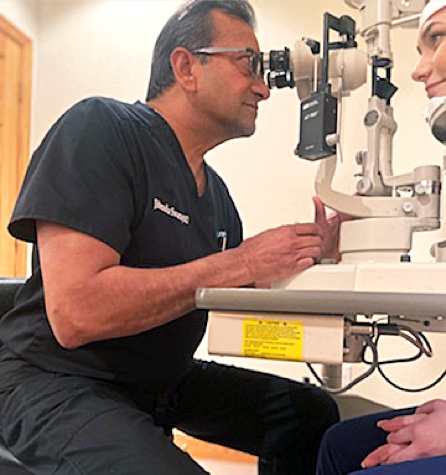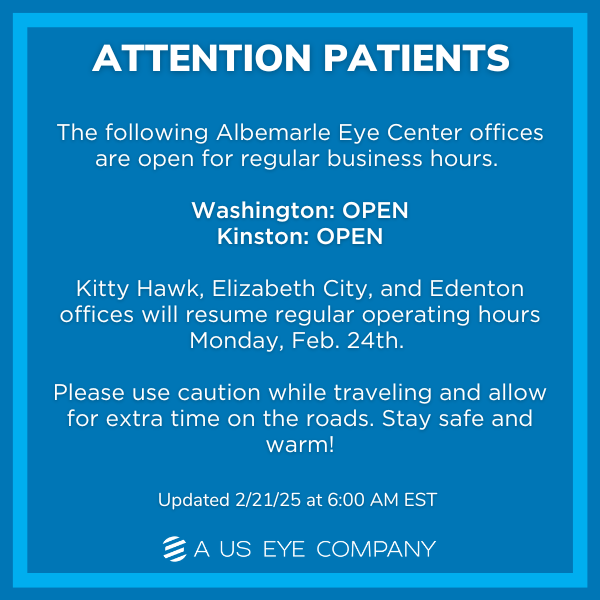Reviewed By: Dr. Jitendra Swarup, M.D.
The field of ophthalmology has made breakthroughs with the Light Adjustable Lens (LAL) from RxSight, changing the nature of post-cataract-surgery vision correction. Albemarle Eye Center (AEC) is now among the first practices in Washington, North Carolina, to offer this technology, and on April 24 Dr. Jitendra Swarup performed AEC’s inaugural LAL procedure. The premium lens enables precise adjustments to vision after surgery, providing patients with an unprecedented level of post-operative customization.
With the ability to fine-tune vision to near perfection, the RxSight LAL uses a special photosensitive material that reacts to UV light, allowing targeted changes to the lens’s power for optimal clarity. A final UV treatment then “locks in” the prescription for results tailored to each eye. As Dr. Swarup notes, “Because small variations in healing are common, the Light Adjustable Lens lets us fine-tune the outcome for every patient’s unique lifestyle.”
This blog explains how LAL enhances patient satisfaction by offering precise, customizable vision correction like never before. Learn more about the innovative lens and how Albemarle Eye Center’s five locations—Edenton, Elizabeth City, Kinston, Kitty Hawk, and Washington—are bringing it to eastern North Carolina.
What Is the RxSight Light Adjustable Lens (LAL)?
The RxSight Light Adjustable Lens is an intraocular lens (IOL) used in cataract surgery and refractive lens-exchange procedures. Unlike traditional IOLs, AEC’s LALs can be adjusted after surgery to optimize visual outcomes. These lenses are made of a unique photosensitive material that reacts to ultraviolet (UV) light.
How Does a Light Adjustable Lens Work?
The science lies in a series of light-treatment sessions after the eye has begun healing:
1. Photosensitive material – Light-sensitive molecules are evenly distributed throughout the lens.
2. External UV light – A specialized UV light source targets the lens in the clinic. The energy triggers molecular changes within the lens material.
3. Fine-tuning – By applying quick, painless light patterns, doctors alter lens curvature to correct refractive errors such as
- Myopia (nearsightedness)
- Hyperopia (farsightedness)
- Astigmatism
4. Non-invasive adjustments – Everything is done externally; no additional incisions are required.

Benefits of Light Adjustable Lenses
- Customized vision – Final prescription is set after the eye’s natural healing variations are known.
- Postoperative flexibility – Adjustments can target distance, intermediate, or near focus.
- Improved accuracy – Studies show a higher likelihood of achieving 20/20 or better without glasses.
- Safety – Treatments are quick, painless, and performed under your surgeon’s control.
Combining RxSight LAL Technology with Laser Cataract Surgery
Pairing AEC’s Light Adjustable Lenses with femtosecond laser-assisted cataract surgery (FLACS) pushes customization even further. Laser precision during lens removal and placement reduces variability, while post-surgery light treatments hone the prescription. The approach may allow many patients to reach 20/20 vision—or better—without additional surgical touch-ups.
A Milestone for Albemarle Eye Center
Cataract surgery is the most common surgical procedure in the United States, and demand will rise as the population ages. Introducing the Light Adjustable Lens positions Albemarle Eye Center at the forefront of cataract technology in eastern North Carolina and the broader US Eye network.
To schedule a cataract consultation or learn whether the LAL is right for you, call 1-888-873-9348 or visit any AEC location.
**Please note that the suggestions provided in this blog are for general informational purposes only and may not be suitable for your specific insurance plan and eye care needs. It is important to consult a qualified healthcare professional for personalized advice on laser treatment for glaucoma or cataracts.**


















